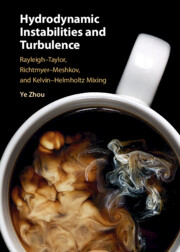 Hydrodynamic Instabilities and Turbulence
Hydrodynamic Instabilities and Turbulence from Part 2 - Hydrodynamics of Complex Flows
This chapter contains a discussion of the coupling of a magnetic field, through the framework of magnetohydrodynamics (MHD), to the hydrodynamic body forces. This leads to an additional body force, namely the Lorentz force on electrical currents in the fluid. Due to their conductivity, this effect is especially important for ionized plasmas. The intuitive result is that the magnetic field lines follow the flow, and they have an effective tension that can stabilize the RTI. As with the RTI, the RMI can be suppressed by a magnetic field.
To save this book to your Kindle, first ensure [email protected] is added to your Approved Personal Document E-mail List under your Personal Document Settings on the Manage Your Content and Devices page of your Amazon account. Then enter the ‘name’ part of your Kindle email address below. Find out more about saving to your Kindle.
Note you can select to save to either the @free.kindle.com or @kindle.com variations. ‘@free.kindle.com’ emails are free but can only be saved to your device when it is connected to wi-fi. ‘@kindle.com’ emails can be delivered even when you are not connected to wi-fi, but note that service fees apply.
Find out more about the Kindle Personal Document Service.
To save content items to your account, please confirm that you agree to abide by our usage policies. If this is the first time you use this feature, you will be asked to authorise Cambridge Core to connect with your account. Find out more about saving content to Dropbox.
To save content items to your account, please confirm that you agree to abide by our usage policies. If this is the first time you use this feature, you will be asked to authorise Cambridge Core to connect with your account. Find out more about saving content to Google Drive.